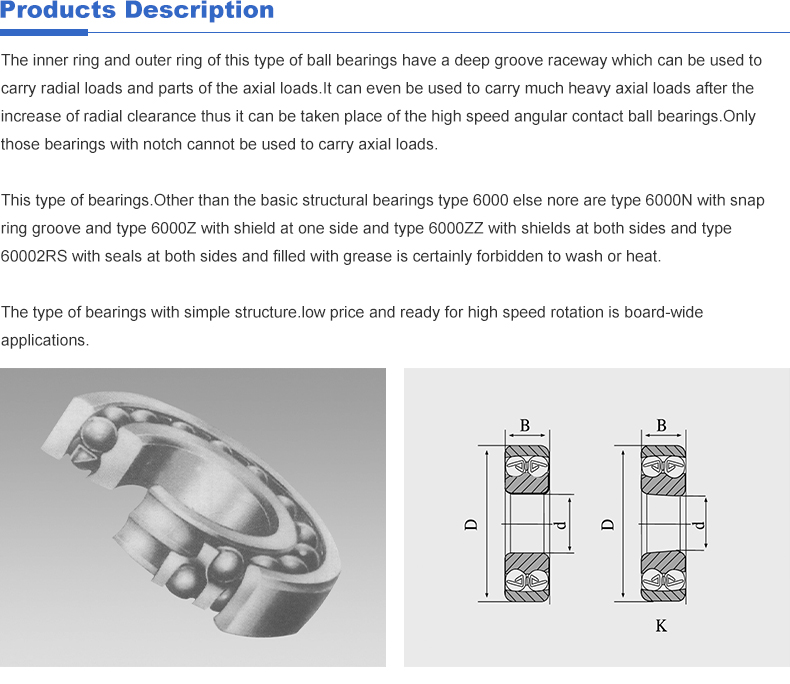
Dec . 04, 2024 11:19 Back to list
Guidelines for Proper Installation of Spherical Roller Bearings in Machinery
Installing Spherical Roller Bearings A Comprehensive Guide
Spherical roller bearings are a crucial component in various industrial applications, offering excellent load-carrying capacity and adaptability to misalignment. Proper installation of these bearings is essential to ensure optimal performance, longevity, and efficiency. This article will guide you through the essential steps and considerations for correctly installing spherical roller bearings.
Understanding Spherical Roller Bearings
Spherical roller bearings consist of an outer ring, an inner ring, and a set of spherical rollers that facilitate rotation. The design allows for a degree of misalignment between the shaft and housing, making these bearings especially useful in heavy-duty applications such as construction machinery, mining equipment, and industrial gearboxes.
Preparation for Installation
Before beginning the installation process, it’s critical to prepare adequately. Here are some steps to follow
1. Gather Necessary Tools and Equipment Ensure you have the correct tools, including a bearing press, appropriate socket wrenches, a torque wrench, and other associated equipment like feeler gauges and cleaning materials.
2. Inspect the Bearings and Components Before installation, inspect the spherical roller bearing and the housing for any damage, rust, or contamination. Also, check the shaft for wear. Any blemishes or foreign matter can lead to premature failure.
3. Temperature Considerations Bearings are often best installed at elevated temperatures. Heating the outer ring can help expand it slightly, allowing for easier installation onto the shaft. A common method is to place the bearing in an oven at around 80-100 degrees Celsius.
Installation Steps
1. Clean the Components Thoroughly clean the bearing, the shaft, and the housing. Use a suitable solvent to remove any grease, dirt, or debris, which might compromise the bearing’s performance.
2. Apply Lubrication Use a high-quality lubricant recommended by the bearing manufacturer to coat the internal surfaces of the bearing. Proper lubrication is essential in minimizing friction during operation and enhancing overall efficiency.
spherical roller bearing installation

3. Align the Bearing Position the bearing over the shaft. Ensure that it is aligned correctly, as misalignment can lead to increased wear and premature failure.
4. Install the Bearing Utilizing the bearing press, carefully apply even pressure while installing the bearing onto the shaft. Avoid using direct impact tools, as this can cause brinelling or other forms of bearing damage.
5. Secure the Bearing Once the bearing is in place, install any locking mechanisms or end caps to secure it. Ensure that these components are fastened to the manufacturer’s specified torque settings to avoid loosening during operation.
Post-Installation Checks
After installation, perform a series of checks
1. Rotation Test Manually rotate the shaft to check for smoothness. There should be no binding or excessive resistance, which indicates improper installation or misalignment.
2. Monitor Initial Operation During the first few hours of operation, monitor the bearing for unusual noise or vibration. Initial runs can reveal installation issues that need to be addressed promptly.
3. Check for Temperature Use infrared temperature sensors to ensure that the bearing does not overheat. Elevated temperatures can be a sign of incorrect installation or inadequate lubrication.
Maintenance Tips
To extend the lifespan of spherical roller bearings, regular maintenance is crucial. Keep the bearings clean and well-lubricated, and perform routine inspections to identify potential issues before they become significant problems. Always adhere to the manufacturer's guidelines regarding lubrication intervals and conditions.
Conclusion
Spherical roller bearings are vital for the efficient operation of machinery in various industries. Proper installation is key to maximizing their performance and longevity. By following this comprehensive guide, you can ensure that you install spherical roller bearings correctly, ultimately contributing to the overall reliability and efficiency of your equipment. Remember that ongoing maintenance and periodic inspections will help sustain performance over time, reducing the risk of costly breakdowns and enhancing the lifespan of your bearings.
Latest news
-
Premium Deep Groove Ball Bearings | High Speed & Reliability
NewsAug.29,2025
-
Durable Scaffolding Clamps - Secure & Reliable Tube Connectors
NewsAug.28,2025
-
Common Failures in Thrust Ball Bearings and Solutions
NewsAug.22,2025
-
How Tapered Roller Bearings Can Take Shock Loads
NewsAug.22,2025
-
Angular Bearings in High-Precision Spindles
NewsAug.22,2025
-
The Impact of Misalignment on Cylindrical Roller Bearing Performance
NewsAug.22,2025
